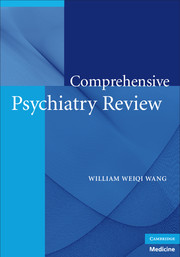Book contents
- Frontmatter
- Contents
- Introduction
- PART I INTELLECTUAL FOUNDATION OF PSYCHIATRY
- PART II EVALUATION AND MEASUREMENT
- PART III PSYCHIATRIC DISORDERS
- PART IV PSYCHIATRIC THERAPEUTICS
- 26 Psychosocial Therapies
- 27 Antipsychotics
- 28 Lithium and Mood-Stabilizing Anticonvulsants
- 29 Antidepressants
- 30 Anxielytics and Hypnotics
- 31 Pharmacotherapy for Substance-Related Conditions
- 32 Cognitive Enhancers
- 33 Stimulants
- 34 Drug Interactions
- 35 Evaluation and Treatment for Adverse Effects
- 36 Electroconvulsive Therapy, Brain Stimulation Therapies, and Other Novel Treatments
- PART V NEUROPSYCHIATRY AND RELEVANT NEUROLOGIC CONDITIONS
- PART VI SPECIAL TOPICS
- PART VII REVIEW QUESTIONS
- Bibliography
- Index
36 - Electroconvulsive Therapy, Brain Stimulation Therapies, and Other Novel Treatments
from PART IV - PSYCHIATRIC THERAPEUTICS
Published online by Cambridge University Press: 18 January 2010
- Frontmatter
- Contents
- Introduction
- PART I INTELLECTUAL FOUNDATION OF PSYCHIATRY
- PART II EVALUATION AND MEASUREMENT
- PART III PSYCHIATRIC DISORDERS
- PART IV PSYCHIATRIC THERAPEUTICS
- 26 Psychosocial Therapies
- 27 Antipsychotics
- 28 Lithium and Mood-Stabilizing Anticonvulsants
- 29 Antidepressants
- 30 Anxielytics and Hypnotics
- 31 Pharmacotherapy for Substance-Related Conditions
- 32 Cognitive Enhancers
- 33 Stimulants
- 34 Drug Interactions
- 35 Evaluation and Treatment for Adverse Effects
- 36 Electroconvulsive Therapy, Brain Stimulation Therapies, and Other Novel Treatments
- PART V NEUROPSYCHIATRY AND RELEVANT NEUROLOGIC CONDITIONS
- PART VI SPECIAL TOPICS
- PART VII REVIEW QUESTIONS
- Bibliography
- Index
Summary
Treating mental illness with physical technologies provides effective alternatives to psychopharmacology. Physical technologies were used before and around the birth of psychopharmacology to bring impact on impaired brain function. Though considered by some to be antiquated, several of these treatments have gone through continuous technical refinement and remain active in mainstay psychiatry. New technologies have been developed in recent years and offered hope for more powerful and safer treatment.
Among the old treatments, the most prominent and publicized one is the electroconvulsive therapy (ECT). ECT is also probably the most controversial treatment in psychiatry. The negative perception of ECT may be traced to its historical stages of crude technology, and further, largely influenced by motion pictures that rarely depicted ECT in reasonable resemblance to modern practice. The use of anesthesia, muscle relaxant, and brief pulse are among the technical advancements that have made ECT a much safer procedure. Research has proved ECT the most effective treatment for major depression, a rapidly effective treatment for a spectrum of life-threatening psychiatric conditions, and under many circumstances a safer option of treatment.
Psychosurgery, though not a brain stimulation therapy, bore similar scrutiny as ECT did, and remains active because of its efficacy in a small group of severe cases.
New developments described here include vagus nerve stimulation and transcranial magnetic stimulation, both are Food and Drug Administration (FDA) approved treatments for depression, and deep brain stimulation, which is FDA approved for treatmentresistant, obsessive-compulsive disorder, and Parkinson's disease.
Cognitive impairment in ECT
▶ Postictal/postanesthetic confusion
[…]
- Type
- Chapter
- Information
- Comprehensive Psychiatry Review , pp. 276 - 284Publisher: Cambridge University PressPrint publication year: 2009



